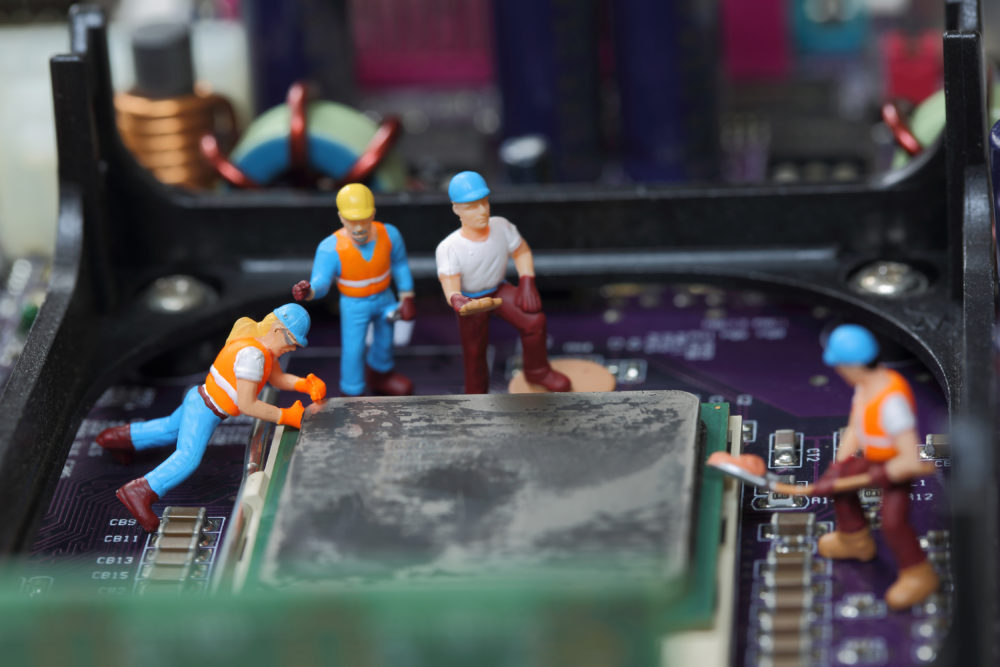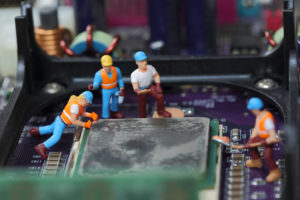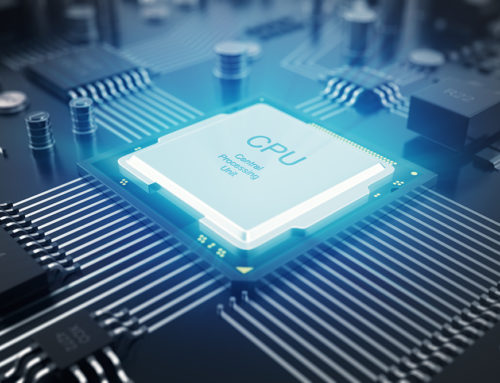

Selective focus of miniature foreman controlling engineer worker to fixed problem and repair Control Processing Unit (CPU), mainboard computer as industry concept.
As William Shakespeare once wrote: “To upgrade, or not to upgrade: that is the question.” Er, hold on… that doesn’t sound right. “To update, or not to…” Nope, that isn’t right either. Though the world’s most famous bard probably didn’t have the firmest grasp of when you should (or shouldn’t) upgrade your workstation, at least he gave us Hamlet and the word “puppy-dog.” And luckily for you, our technical expertise begins where his ends. Hardware lifecycle management is decidedly our wheelhouse.
One of the biggest issues that companies with large inventories face is outdated workstations. Not only is this frustrating for the workers who use them, which is bad for employee morale, but it can also hamper productivity. The problem is: with upgrading, the general rule of thumb is… there is no rule of thumb. Figuring out a hardware lifecycle management strategy can be about as straightforward as a “Choose Your Own Adventure” novel. Is your computer slow? Turn to page 81. Are hardware troubles the reason? Turn to page three hundred and ninety-four.
If hardware troubles are in fact the reason behind your computer’s slowness, you’re likely to quickly find that replacing components piecemeal is more trouble than it’s worth. The better course of action, extreme as it might sound, would probably to overhaul your fleet of workstations. The biggest reason for this is two-fold. First, technology is advancing at such a rapid pace that it can be all too easy to be left behind. The second is that many business computers only have a lifespan of 3-5 years, with warranties ending around year three. If you’re still under warranty, replacing parts might be the most cost effective measure. But making decisions on cost alone isn’t always the best financial decision in the long run.
As companies look for new ways to reduce costs and go lean, many of them assume they can get away with using their existing technology until they “can’t ride that horse no more.” While buying a car and running it into the ground might make some sense financially, taking that approach with your workstations is counterproductive. That approach goes down even worse when applied to a company’s business servers, and it’s not hard to see why: your server is the backbone of you network infrastructure!
In an attempt to squeeze every bit of value out of an aging server, you sacrifice efficiency in the name of cost. And often, you sacrifice cost as well. Did you know that servers suffer an appreciable decline in peak performance annually? A four year old server can actually be expected to run at less than 55% of its original, out of the box capacity. Generally speaking, the effective lifespan of a server isn’t much more than 3 years, like your employee workstations, but that doesn’t stop companies from trying to eke as many as 10 out of their little black boxes.
In doing so, companies frequently turn to replacement parts and periodic upgrades in an attempt to stave off end-of-life, but this means contending with mounting application management and server administration expenditures — not to mention the skyhigh price of trying to cool down an energy-guzzling legacy server. Instead of throwing cash at a device that typifies the “sunk cost fallacy,” it makes more sense to come to terms with one of technology’s least convenient truths: everything has a lifecycle. Nothing functions perfectly forever.
This truth is probably no better typified than by the world of software. Think about how often you have to update the apps on your phone. Companies are constantly striving to make improvements to their products. Sometimes, those improvements come in the form of a patch. Other times, a whole new iteration is necessitated. That’s how the world ended up with Windows 10 following the disastrous rollouts of 8 and 8.1.
But you’re probably not using Windows 10 yet, are you? Don’t worry, you’re not alone. While home users have long since made the switch to Windows 10, a lot of businesses are still stuck on Windows 7. Honestly though, we don’t blame them. It was a great release, and employees worldwide love it. But, as with all good things, it must come to an end: Microsoft 7 has officially been given an end-of-life date. We know! It’s sad. But it’s for the greater technological good — we promise!
On January 10, 2020 Microsoft will discontinue support, meaning you will no longer receive security updates. The reason for this is because it doesn’t make sense to continue development on a piece of outdated software, meaning Microsoft will stop releasing updates or security patches. Without these patches, companies remaining on Windows 7 will be more vulnerable to hackers than ever before.
Windows Server 2008 is facing the same fate. Once the workhorse of your server room, now it’s being replaced by something you can’t even touch: The Cloud. With an end of life approaching rapidly (it will also come in January 2020), it’s important for you to start planning your next steps now. Do you intend to simply upgrade the software on your existing server, or will you be migrating to the cloud?
It’s a big decision for any company, and not the kind you really want to leave until the last minute. By designing a plan for managing the IT various life cycles of your business’ assets, you take the stress out of these types of choices, while also ensuring an unwelcome surprise never leaves you scrambling. I mean, if something breaks, the last thing you want to learn is that you’re three weeks out of warranty, right? So why leave that to chance?
Considering that the role of technology in business is only growing, we understand how nerve wracking this stuff can be — especially if you’re trying to stay one step ahead of your competition. Sometimes it feels like one big domino effect, doesn’t it? It’s never as simple as “adopting a new operating system” or “migrating to the cloud.” It’s far more involved. But that’s why we’re here… to do the heavy lifting. So don’t get caught with your pants down by a totally preventable lapse in technology.
Keep on top of your IT assets with a robust lifecycle management strategy through JNT TEK, and have the peace of mind knowing that no matter what hiccups and catastrophes the universe throws at you, you’ll never miss a beat.
Contact JNT TEK for recommendations on how to upgrade your company’s existing technology.


CONNECT WITH US!